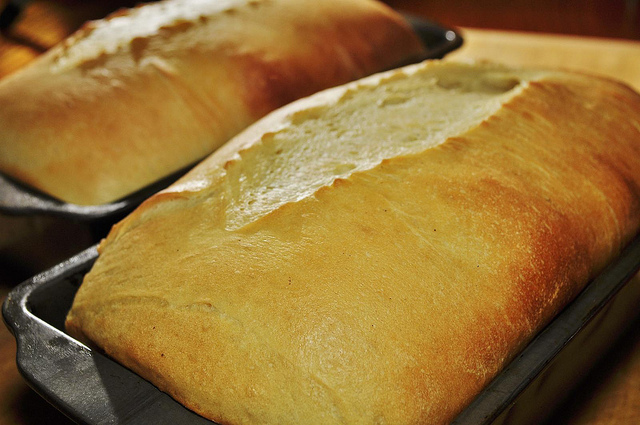
Last weekend I was given a sourdough starter by a friend.
It’s something I’ve dreamed of having for some time now and am so grateful to have it because sourdough starter means I can bake my own bread.
It means I can produce my own food and allows me to break free from the industrial food system and be on a system of my own. And I like that. I really appreciate the opportunity to break away because it has the most delicious rewards.
Baking bread is a fun, leisurely activity. It involves skill, precision and hard work, but it is well worth it. It allows a person the opportunity to shift their mindset from a consumer to a producer. In a world where we are constantly being asked to consume, consume, consume—it’s nice to be able to take a break from that and be a producer for a change.
If the American food industry had its way, they would make us all consumers all the time. They relish the opportunity to serve our every need and turn us into cogs of their capitalist regime. They relish the opportunity to bake bread for us, to make it as quickly and efficiently as possible for us. This means they are in control of what we eat and can take advantage of us as a society through this control.
The American bread industry has one goal: to feed the consumer as much bread as it possibly can. This means they are working hard to lower the price of bread so that we buy more of it. Also, they are constantly working to create more bread for us to eat to meet the demand in the marketplace. This means they work hard to keep us from making our own bread because making our own bread would work against their best interests.
The American bread industry uses cheap ingredients and adds fillers and additives whenever they can to speed up the process. While bread traditionally has been made with nothing more than three ingredients, industrial bread is made with 31 to 37 different ingredients. This is bad for the consumer because it takes away from the nutritional value of the bread and adds to a multitude of problems that arise from eating the bread like the products these companies produce.
The beauty of baking bread is that we are in complete control of the process. From start to finish, we know exactly what is going into it.
Baking bread is an art, as well as understanding the process with which it is made.
You have to understand science because a sourdough starter is actually a live yeast culture. You have to create a symbiotic relationship with your starter because your culture is alive until the moment you put it in the oven. You have to be patient because it takes time to bake a good loaf of bread. You have to understand nutrition because a homemade loaf of bread is more nutritious than a purchased loaf of bread. And you have to understand tradition because baking bread is a product of thousands of years of history.
When we bake bread, we have an opportunity to make conscious decisions about the food we eat. There are many steps involved in the process of baking bread: we have to purchase the ingredients, start the starter, proof it, knead it, bake it and then eat it.
We get to take a stance against the industrial food system when we decide to bake our own bread. There is a correlation between the the choices we make in the kitchen and the effect it has on the industry at large. Would you rather eat a bread-like product made of 37 ingredients or would you rather eat bread made from three ingredients?
Out of convenience many would probably say the one made with 37 ingredients, but at what cost? With the growing trend in gluten avoidance in America, it’s safe to question whether it’s really gluten making us sick or if it’s the 33 questionable ingredients in industrial bread that are troubling our guts.
Here’s a recipe to make your own sourdough starter at home, so you can also take a stance against the industrial food system and produce your own food:
Sourdough Starter Recipe (Adapted from The Kitchn)
Ingredients:
All-purpose flour (or a mix of all-purpose and whole grain flour)
Water, preferably filtered
Equipment
2-quart glass or plastic container (not metal)
Measuring cups
Mixing spoonPlastic wrap or container lid
Instructions
Making sourdough starter takes about 5 days. Each day you “feed” the starter with equal amounts of fresh flour and water. As the wild yeast grows stronger, the starter will become more frothy and sour-smelling. Be aware that it can take longer to start your starter depending on the conditions in your kitchen. As long as you see bubbles and signs of yeast activity, continue feeding it regularly.
Day 1: Make the Initial Starter:
3/4 cup + 2 tablespoons all-purpose flour
1/2 cup water
Weigh the flour and water and combine them in the container. Stir vigorously until combined into a smooth batter. It will look like a sticky, thick dough. Scrape down the sides and loosely cover the container with plastic wrap or the lid (left ajar). Put the container somewhere with a consistent room temperature of 70°F to 75°F (like the top of the refrigerator) and let sit for 24 hours.
Day 2: Feed the Starter:
3/4 cup + 2 tablespoons all-purpose flour
1/2 cup water
Take down your starter and look at it. If you see a few small bubbles here and there that’s good! The bubbles mean that wild yeast have started making themselves at home in your starter. They will eat the sugars in the the flour and release carbon dioxide (the bubbles) and alcohol. They will also increase the acidity of the mixture, which helps fend off any bad bacterias. At this point, the starter should smell fresh, mildly sweet, and yeasty.
If you don’t see any bubbles yet, don’t panic—depending on the conditions in your kitchen, the average room temperature and other factors, your starter might just be slow to get going.
Weigh the flour and water for today and combine them in the container. Stir vigorously until combined into a smooth batter. It will look like a sticky, thick dough. Follow the same instructions as yesterday.
Day 3: Feed the Starter:
3/4 cup + 2 tablespoons all-purpose flour
1/2 cup water
Check your starter. By now, the surface of your starter should look dotted with bubbles and your starter should look visibly larger in volume. If you stir the starter, it will still feel thick and batter-like, but you’ll hear bubbles popping. It should also start smelling a little sour and musty.
Again, if you don’t see any bubbles in your starter yet don’t worry. It may take a little longer for yours to get started.
Weigh the flour and water for today, and combine them in the container. Stir vigorously until combined into a smooth batter. It will look like a sticky, thick dough. Follow the same instructions as you have done for the last two days.
Day 4: Feed the Starter:
3/4 cup + 2 tablespoons all-purpose flour
1/2 cup water
Check your starter. By now, the starter should be looking very bubbly with large and small bubbles, and it will have doubled in volume. If you stir the starter, it will feel looser than yesterday and honeycombed with bubbles. It should also be smelling quite sour and pungent. You can taste a little too! It should taste sour and somewhat vinegary.
Weigh the flour and water for today, and combine them in the container. Stir vigorously until combined into a smooth batter. It will look like a sticky, thick dough. Store as per the first three days.
Day 5: Starter is Ready to Use:
Check your starter. It should have doubled in bulk since yesterday. By now, the starter should also be looking very bubbly—even frothy. If you stir the starter, it will feel looser than yesterday and be completely webbed with bubbles. It should also be smelling quite sour and pungent. You can taste a little too! It should taste even more sour and vinegary.
If everything is looking, smelling, and tasting good, you can consider your starter ripe and ready to use! If your starter is lagging behind a bit, continue feeding it until it is ready to use.
Michael Pollan states that “to cook for the pleasure of it, to devote a portion of our leisure to it, is to declare independence from the corporations seeking to organize our every moment into yet another occasion for consumption.”
Baking bread is a beautiful and delicious hobby to have. It’s extremely enjoyable and we should all take advantage of it and its delicious rewards. Baking bread connects us with the world we live in and reminds us of the symbiotic relationship we have with nature.
We should all bake bread more regularly, and reconnect with this ancient, cultural art that defines us as a species.
~
Author: Alex McGinness
Editor: Sarah Kolkka
Image: jeffreyw/Flickr
 Share on bsky
Share on bsky





Read 0 comments and reply